Flashback to grade school P.E.: the room is buzzing with excitement as you and your classmates line up for the ultimate fitness showdown—the plank test. Who could hold it the longest? Who had the grit to outlast the rest? It was a test of sheer willpower back then, but you didn’t realize how much it revealed about your strength and stability. Fast-forward to today, and you’re likely wondering how long you need to hold a plank to test your core strength. We have the answer and much more to ensure your abs are as solid as they can be.
The plank isn’t just about endurance; it’s a gold-standard measure of core strength that remains as relevant today as it was in those gymnasium glory days. Why? Because your core is the engine of your body. It connects your upper and lower halves, powers athletic performance, supports everyday movement, and helps shield you from injury. It’s your secret weapon for lifting heavier, running faster, and even sitting upright for hours on end. And let’s be honest—a strong, toned midsection is a win in anyone’s book.
So, how long should you hold a plank to claim true core mastery? In this article, we’ll break it down for you. Learn the benchmark for bullet-proof core strength, master the perfect plank form, and discover the best exercises to boost your plank game to new heights.
In This Article
How to Perform the Perfect Plank
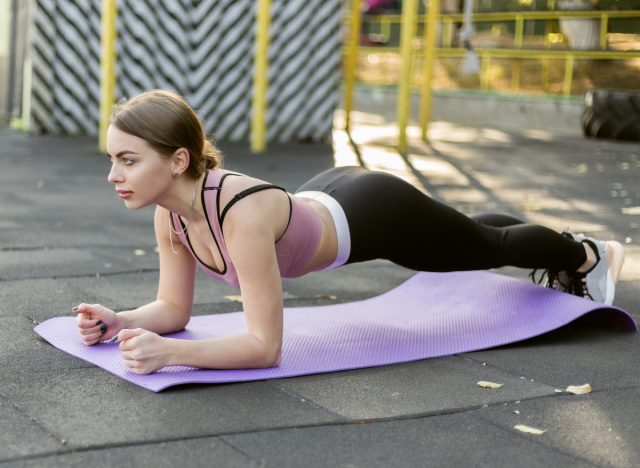
Before you test your endurance, you must nail the fundamentals of proper plank form. Follow these steps to achieve the perfect plank:
- Get into position: Begin face-down on the floor, resting on your forearms and toes. Place your elbows directly under your shoulders with your forearms parallel.
- Align your body: Keep your head, neck, spine, and hips straight. Avoid sagging your lower back or hiking your hips.
- Engage your core: Tighten your abdominal muscles by pulling your belly button toward your spine and slightly tucking your pelvis.
- Activate supporting muscles: Squeeze your glutes, quads, and shoulder blades to maintain stability and distribute the workload.
- Maintain tension: Press through your forearms, keep your breathing steady, and hold the position without losing form.
Here’s How Long You Need To Plank
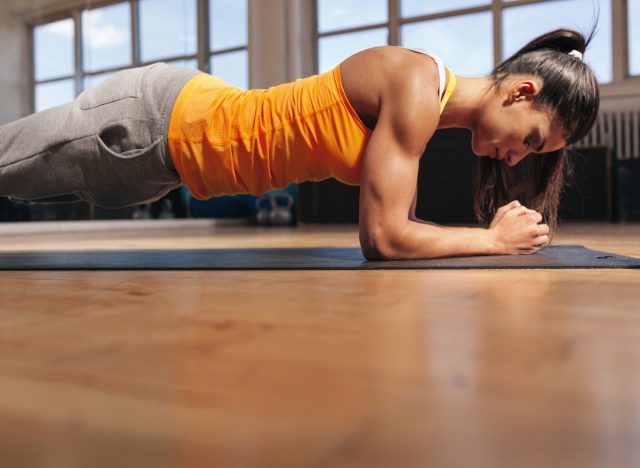
How long should you hold a plank to demonstrate bullet-proof core strength? While there’s no universally agreed-upon standard, a solid benchmark is holding a plank for two minutes with proper form. This duration signifies a well-conditioned core capable of supporting athletic performance, reducing injury risk, and handling the demands of daily life with ease.
Why two minutes? This duration challenges the endurance of your core stabilizers, including the rectus abdominis, transverse abdominis, and obliques, without overloading your lower back or compromising your form. It balances strength and stamina, ensuring your core is strong and functional.
That said, don’t worry if you’re not there yet! Core strength and plank endurance are skills you can develop with time and consistent practice. Start with manageable intervals—20, 30, or 40 seconds—and gradually increase your hold time as your strength improves. The key to reaching the two-minute milestone is progressive overload, where you challenge your muscles with slightly more effort over time.
The Best Exercises to Improve Your Plank
1. Plank

Why: The plank is the foundation of core training, emphasizing strength and stability through isometric contraction. It engages the rectus abdominis, obliques, and transverse abdominis while activating the glutes, shoulders, and quads for total-body tension. This builds a strong, functional midsection to support daily movement and athletic performance.
How To Do It:
- Start on the floor, resting on your forearms with elbows directly beneath your shoulders.
- Extend your legs back, toes tucked under, forming a straight line from head to heels.
- Engage your core, squeeze your glutes, and keep your hips level. Avoid sagging or arching your lower back.
- Hold this position for the prescribed duration while maintaining proper form.
Sets and Reps: 3–4 sets of 20–60 seconds. Gradually increase your hold time.
2. Plank with Shoulder Taps
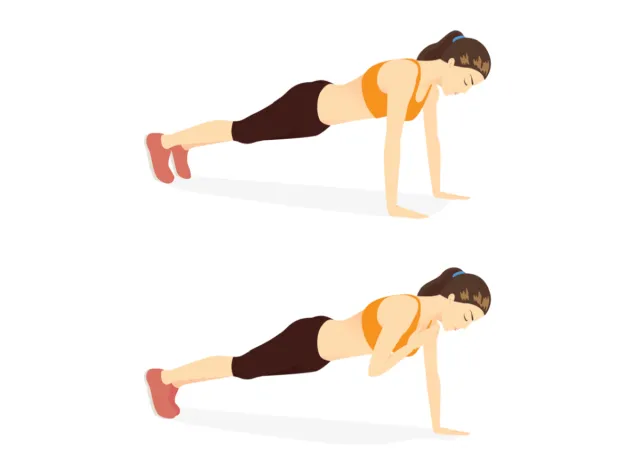
Why: This variation challenges your core’s ability to resist rotation, requiring stability while you alternate tapping each shoulder. It strengthens your anti-rotational muscles, improves balance, and enhances control in athletic and daily movements.
How To Do It:
- Begin in a high plank position with your hands under your shoulders and feet shoulder-width apart.
- Keeping your hips steady, lift one hand and tap the opposite shoulder.
- Return your hand to the floor and repeat with the other hand.
- Focus on keeping your hips level and minimizing any twisting.
Sets and Reps: 3–4 sets of 10–15 taps per side.
3. Side Plank Holds
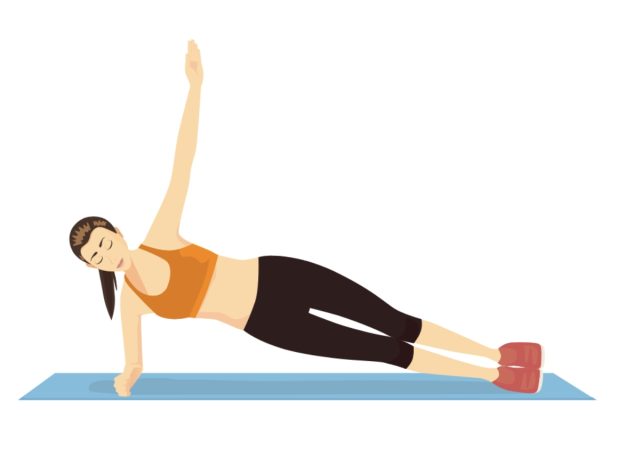
Why: Side planks target the obliques and lateral stabilizers, which are essential for improving spinal stability and preventing injuries. They are particularly effective for enhancing performance in lateral movements and creating a defined waistline.
How To Do It:
- Lie on one side, propped up on your forearm, with your elbow directly under your shoulder.
- Stack your feet or place one foot in front of the other for balance.
- Engage your core and lift your hips until your body forms a straight line from head to heels.
- Hold the position while keeping your hips elevated and your core engaged.
Sets and Reps: 3 sets of 20–40 seconds per side.
4. Weighted Planks
Why: Adding resistance to a standard plank increases the challenge to your core, requiring more significant effort to maintain stability. The increased intensity builds strength and endurance, making your core more resilient against external forces during activities like lifting and carrying.
How To Do It:
- Assume a standard forearm or high plank position.
- Have a training partner place a weight plate on your upper back, or position it carefully yourself before beginning.
- Engage your core, glutes, and shoulders, ensuring your back stays straight and hips level.
- Hold the position for the prescribed duration.
Sets and Reps: 3–4 sets of 20–45 seconds.
5. Plank with Pull-Throughs
Why: This exercise introduces an anti-rotational challenge, requiring your core to stabilize as you move a weight. It also engages your shoulders and back, making it a full-body exercise that improves coordination and dynamic control.
How:
- Start in a high plank position with a dumbbell or kettlebell placed just outside one hand.
- Drag the weight across your body to the other side using your opposite hand.
- Alternate hands and repeat, keeping your hips square to the floor.
- Avoid letting your hips sway as you move the weights.
Sets and Reps: 3 sets of 8–12 pull-throughs per side.
6. Plank Up-Downs
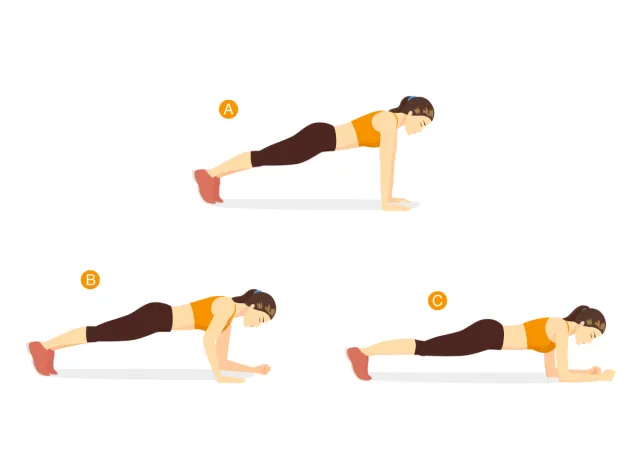
Why: This dynamic plank variation combines core stability with upper body strength. It works the shoulders, triceps, chest, and core, improving endurance, coordination, and functional strength.
How:
- Start in a high plank position with your hands directly under your shoulders.
- Lower one arm so your forearm rests on the floor, followed by the other arm, transitioning to a forearm plank.
- Reverse the movement by pressing one hand into the floor, followed by the other, returning to a high plank.
- Alternate which arm leads the movement on each repetition.
Sets and Reps: 3 sets of 10–12 repetitions.
Jarrod Nobbe, MA, CSCS








